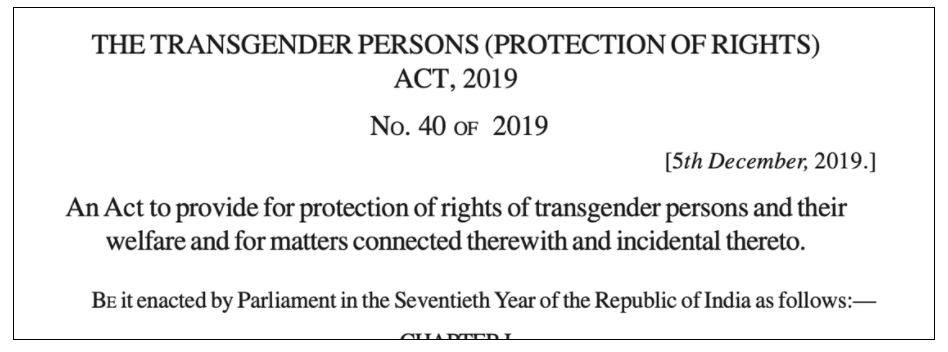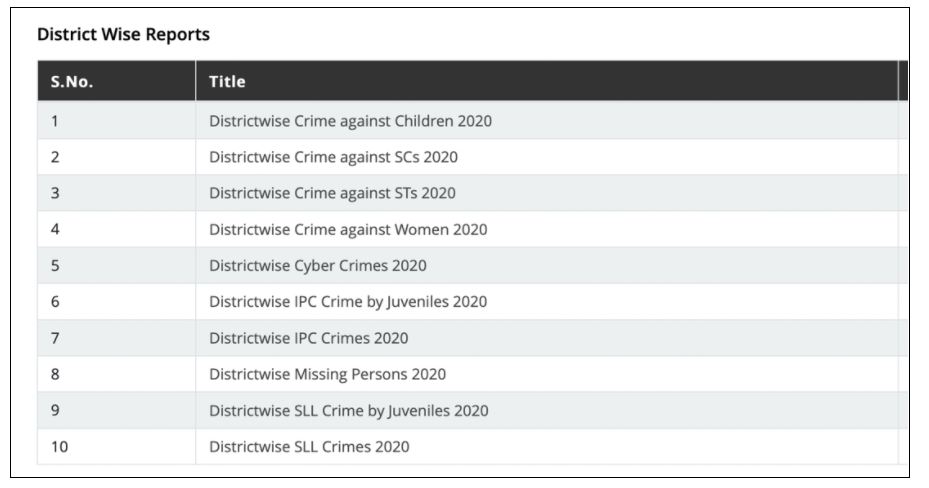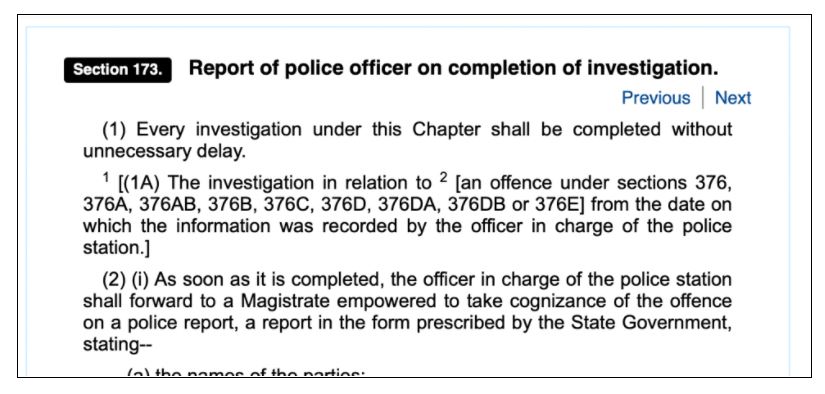The NCRB recently released its 2020 edition of the annual ‘Crime in India’ report, which provides data on various crimes registered in the country and their disposal. But what changes have been made to the 2020 report? What additional data is included? Here is a review.
The 68th edition of the Crime in India Report (CII)- “Crime in India 2020” was released by National Crime Records Bureau (NCRB) on 14 September 2021. The CII report is being published since 1954 and provides data & insights into the crimes registered, the status of cases & their trials, etc., reflecting the overall state of law & order in the country. Over the years, NCRB has made changes to the CII report to include additional data, information & methodology to help better interpret the data related to the crimes.
In an earlier story, we reviewed the changes made in the CII-2017 report. In this story, we look at the key improvements & additions made to the ‘Crime in India 2020’ report.
‘Chargesheeting Rate’ included as a new indicator
Among the major improvements made in the 2020 report, is the ‘Chargesheeting Rate’. The NCRB mentions that the inclusion of ‘Chargesheeting Rate’ provides a better understanding of police performance.
As per Section 173 of the Code of Criminal Procedure, 1973, the police officer is obliged to file a report after the completion of the necessary investigation of an offence.
The report is referred to as a ‘Chargesheet’ in common parlance. The investigation agencies prepare this report based on the investigation conducted by them to prove the accusation of a crime in the court of law. This report informs the court that investigation in a particular case is conducted and that sufficient evidence for the offence is found, and that the court can proceed further with the trial.
This is different from the FIR (First Information Report), which is a written record of the information provided by the informant/complainant, whereas a ‘Chargesheet’ is filed after the investigation is conducted.
The Chargesheet needs to be filed within 60 days from the date of arrest of the accused in the cases triable by the lower courts and 90 days in cases triable by the Court of Sessions. Therefore, ‘Chargesheet’ reflects the details of the investigation carried on by the Police/ investigation authorities and is the basis for the court trial.
Hence, the inclusion of ‘Chargesheeting Rate’ in the current NCRB’s CII report is an important indicator in an understanding of the police performance. In the earlier reports, the information only included the number of cases filed and the status of these cases in the courts. ‘Chargesheeting Rate’ provides a key bridge between the information on cases filed and the final action on these cases.
The ‘Chargesheeting Rate’ implies the percentage of Cases Chargesheeted out of the total cases disposed off by the police.

Variations in Chargesheeting Rates observed across States & Crimes
As per the information provided in NCRB’s 2020 CII report, the Chargesheeting rate for all cases registered under the Indian Penal Code (IPC) in 2020 was 75.8%. This was an improvement over the recent years, where there has been a decline in the Chargesheeting rates since 2015. In 2014, it was 79.6%.
Comparatively the Chargesheeting rates of cases registered under Special & Local Laws (SLL) are higher at 93.8% in 2020. This indicates variation in the Chargesheeting rate across crimes. Here is a snapshot of the Chargesheeting rate across crimes for the year 2020.
- The Chargesheeting Rate of Violent Crimes during 2020 is 75%. Major variations were reported in Chargesheeting rates among the different crimes categorized as violent crimes.
- In the case of Murder, it is 85.3% while in the case of Kidnapping & Abduction, it is only 37.3%.
- In the case of Crimes against women, the Chargesheeting rate is 78.6%. Within the Crimes Against Women, the cases relating to Dowry deaths, Murder with rape, etc. have a higher Chargesheeting rate at around 90%, while kidnapping & abduction reported a lower Chargesheeting rate.
- Comparatively, the Chargesheeting rate for Crimes against children is only around 65%. Even in the case of children, crimes like Murder, murder with rape, etc. have a higher Chargesheeting rate compared to that of kidnapping & abduction.
- Crimes/Atrocities against Scheduled castes have a Chargesheeting rate of around 80%, while in instances of atrocities against STs it is 82%, with variations across crime types.
Apart from the variations across the different crimes, there are large variations in total Chargesheeting rate across the States as well as across specific crimes within states.
The Chargesheeting rate for both IPC & SLL crimes in India for 2020 was 82%. Among the States, Kerala & Gujarat had the highest Chargesheeting rate with 98.4% & 98.3% respectively.
These two states were followed by Uttarakhand, Tamil Nadu, Madhya Pradesh & Andhra Pradesh all of which all have Chargesheeting rate of above 90 %. On the other hand, states of Assam, Haryana, Delhi, Meghalaya & Manipur reported Chargesheeting rates of less than 50%. It is especially lower in Meghalaya & Manipur.
As indicated, the variations also exist within the states across crimes.
- Kerala reported a lower Chargesheeting rate for murder compared to its overall average Chargesheeting rate with 87.8%. Meanwhile, Assam has a higher Chargesheeting rate for murder compared to its overall Chargesheeting rate.
- Among the two Northeast states with lower Chargesheeting rates, Manipur does better with 57%, while Meghalaya is worse-off with only 12% in the case of murder.
- Among the larger states, Kerala, Gujarat, Andhra Pradesh, Telangana, etc. have better Chargesheeting rates in the case of crimes against women with more than 90% compared to that of Bihar & UP with 70-80%, which is lower than their overall Chargesheeting rate.
As a few of these examples indicate, the information relating to Chargesheeting rates provides a new dimension in ascertaining the performance of police & investigation agencies across different states & crimes, which was not available in the earlier editions. Historical information of the previous few years across the states & crimes would help in analysing the trends over the years. Nevertheless, including this information is a big step forward in understanding the state of crime reporting, investigation & trial in the country.
Cases registered under Transgender Persons Protection Act, 2019 included in the latest edition
The Transgender Persons (Protection of Rights Act, 2019) came into effect from 05 December 2019.

The act provides for the measures for the inclusion of transgender persons in society and lays down the offences & penalties which act as barriers towards these goals. Accordingly, the NCRB’s CII 2020 report, provides details of the Crimes committed under Transgender Persons (Protection of Rights Act, 2019). However, only one incident has been reported in 2020 from the state of Tamil Nadu.
Information on Anti-Human trafficking units provided
Another addition to CII 2020 report is the inclusion of information regarding the number of District level Anti-Human trafficking Units (AHUs). Uttar Pradesh has the highest with 75, followed by Madhya Pradesh with 51. The AHUs are in proportion with the number of Police Districts in various states.

‘District wise’ information provided in the latest report
In the earlier reports, the information on various aspects related to crime was available up to the States/UT level and up to Metropolitan Cities (as defined in NCRB). In the latest edition, certain data up to the district level is included. This data is provided as part of the Additional Tables.

It must be noted that the districts referred to in the report are Police Districts & Police Commissionerates, which do not necessarily match with the geographical districts in the country. Nevertheless, the information provides key insights into the prevalence & trends of the crimes in the country at a micro-level than at just the state level or in the large cities. It would be further helpful if crime rates are included for the district level data which would mean ascertaining the population at the police district level or commissioner level.
Overall, the changes made in NCRB’s CII 2020 report are a step in the right direction both in terms of providing additional data on crimes and at a more granular level.
Featured Image: Crime in India 2020 Report



